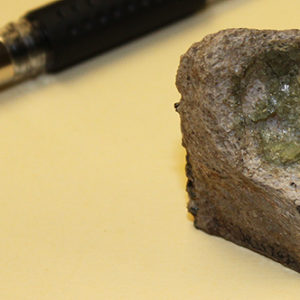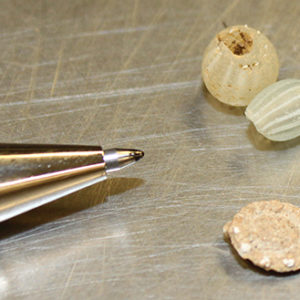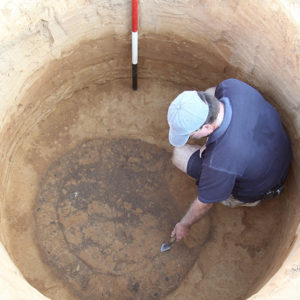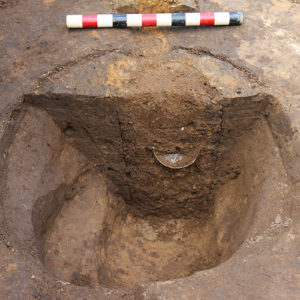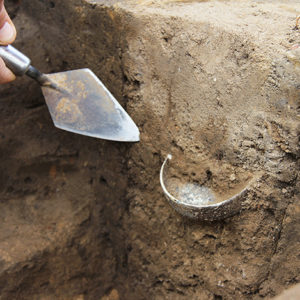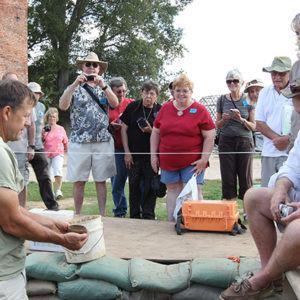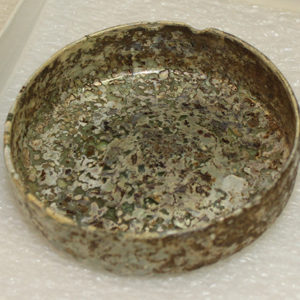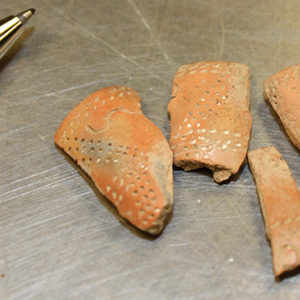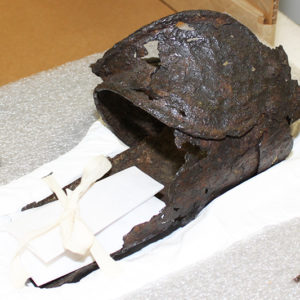Archaeologists are four feet deep in a 17th-century well inside the southwest corner of James Fort’s 1608 church. In spite of its location, the well dates to the mid-17th century, well after the church—and James Fort—ceased to exist. Several artifacts have been found within, a few of which are helping to narrow down the well’s construction date. Work is wrapping up on an early-fort-period building several yards to the north. The structure is very well preserved archaeologically, and has exhibited evidence of metalworking on its premises. The latest find, discovered during the excavation of one of the building’s postholes, is a complete glass vessel used in alchemical labs, very similar in form and function to the modern Petri dish. It’s the first of its kind found since the dig began in 1994, and it is rarer still for its completeness. Work continues on the bombproof of Confederate Fort Pocahontas and preparations are being made to display some of the artifacts found there in a new exhibit in the Voorhees Archaearium.
Archaeologists are now four feet below the surface inside a well in the 1608 church’s southwest corner. Before going much deeper, they will install a metal casing to protect them against any potential cavings-in of the walls. Though the well is neatly situated in the southwest corner of the church, it is likely that its placement is merely coincidence, as artifacts found inside seem to indicate that it was constructed several years after the church was torn down. Dating a well by the artifacts found within is not reliable because in addition to the time the well served as a water source, all of the wells found in and around James Fort also spent varying amounts of time being used as trash dumps after the water turned sour. Because of this, artifacts are often found inside wells that date to well after the date of the well’s construction.
A method that can be reliably used to date wells is analysis of the artifacts found in the well’s builder’s trench. The builder’s trench is the portion of the hole where the builder stands while constructing the wall that defines the actual well shaft. It surrounds the well shaft. In the case of a brick-lined well, the builder’s trench allows a bricklayer to go to the bottom of the well hole and lay the courses of brick, filling in the space outside the brick wall with soil as he progresses toward the surface. This well, a barrel well, is thus named because the well shaft wall is comprised of several barrels stacked on top of one another, with their tops and bottoms removed. Though the construction material is different than the brick example, the method of construction would probably have been much the same, placing a barrel in the hole and filling in the portion of the builder’s trench surrounding it as the builder moved upward.
Because the builder’s trench is filled in when the well is built, any items dropped inside are essentially part of a time capsule, and barring any later disturbance (which could be detected archaeologically), the artifacts cannot date to after the well’s construction. Luckily, some artifacts have been found in the builder’s trench, and among them are several pieces of a tobacco pipe, pipes being among the most readily-dateable artifacts in 17th-century contexts (to learn how curators date tobacco pipes, see Ivor Noël Hume’s comparison). The fragments are from a pipe made by a colonist from local clay, and the bowl is decorated with rouletting, probably influenced by similarly-decorated pipes made by Virginia Indians. By examining the shape and size of the bowl, the pipe can be dated to the mid-17th century. The well, therefore, can be no older than this time period.
By the time the well was constructed, the church and the fort were no longer in existence. James Fort had expanded to become Jamestown, and the palisade walls were torn down. The 1608 church was also dismantled, and its replacement was built in a new location where the Jamestown Memorial Church stands today. The well’s placement in relation to the river and its method of construction seem like a step backwards when compared to the evolution of wells in and around James Fort, and this may indicate that the well was in private rather than public use. The well is very close to the shore of the James River, and the colonists had learned by experience that wells thus situated provided brackish water that was foul tasting and harmful to their health. Perhaps the builder of this well was not living in the colony at the time of the construction of the earlier wells and had not learned that lesson? The well’s diameter is also small compared to the earlier wells, possibly an indicator of a private, smaller-scale construction project. Furthermore, the fact that this is a barrel well rather than a brick-lined or timber-framed one (examples of which have been found in and around James Fort) would seem to indicate a more localized effort.
In addition to the pipe fragments, a few other artifacts of note have been found in the well. Four human teeth have been discovered, some of them having cavities. A fragment of a crucible was also found, with melted bits of glass adhering to the vessel’s interior. Several beads and a lead rosette for a ring have also been found.
Excavations are nearly complete on an early-fort-period structure near the northern corner of the fort. The archaeological footprint of the building is wonderfully preserved and evidence of metalworking was found during the excavations. A complete glass vessel was found this month while excavating one of the structure’s postholes. Similar to a Petri dish in form and function, the vessel was once clear, but has become opaque due to corrosion. This is the first of its kind found at Jamestown.
Work continues on the bombproof of Fort Pocahontas, a Confederate fortification built to defend against incursions by Union ships headed upriver. The bombproof has been excavated to its floorboards, giving the archaeologists a clearer picture of how the structure was constructed. The wooden walls were built outside the bombproof and then were placed in the structure on top of the floorboards. Nails holding the walls together were found with their heads facing the earthen bounds of the structure, making it impossible for the walls to have been constructed from inside. A Minie ball was found during this month’s excavations here. The bullet had been fired as evidenced by striations running along its length. The point of the bullet is crushed, perhaps from hitting a target after being fired.
Bly Straube, Senior Archaeological Curator for the Jamestown Rediscovery Project, is preparing an exhibit focused on artifacts found in and around Fort Pocahontas. The exhibit features some of the latest finds such as an exploded columbiad artillery shell, a button from the Westwood Military School, and a flintlock pistol found on Preservation Virginia property in the 1930s. Also featured in the exhibit will be one of the James Fort-period artifacts found by the enslaved workers who built Fort Pocahontas in 1861. On-loan from the Virginia Historical Society is an iron piece of armor for the arm known as a vambrace. Scheduled to go on display in the Voorhees Archaearium in November 2011, the exhibit is part of the Jamestown Rediscovery project’s commitment to record the findings of and preserve the artifacts found in this fort built over 250 years after the original but in almost exactly the same spot.
related images
- A crucible fragment found in the well. Bits of melted glass adhere to the vessel.
- A lead rosette for a ring (bottom) and some of the beads found in the well
- Archaeologist Dan Smith points to the outline of the well shaft
- The glass vessel in situ
- Another view of the glass vessel in a postmold of the fort-period building
- Archaeologist Don Warmke displays the glass vessel just excavated from the fort-period building’s posthole.
- The glass vessel found in one of the fort-period building’s postholes
- Fragments of a pipe
- The fort-period building
- The vambrace. This piece of armor was found by the enslaved workers who built Fort Pocahontas.



